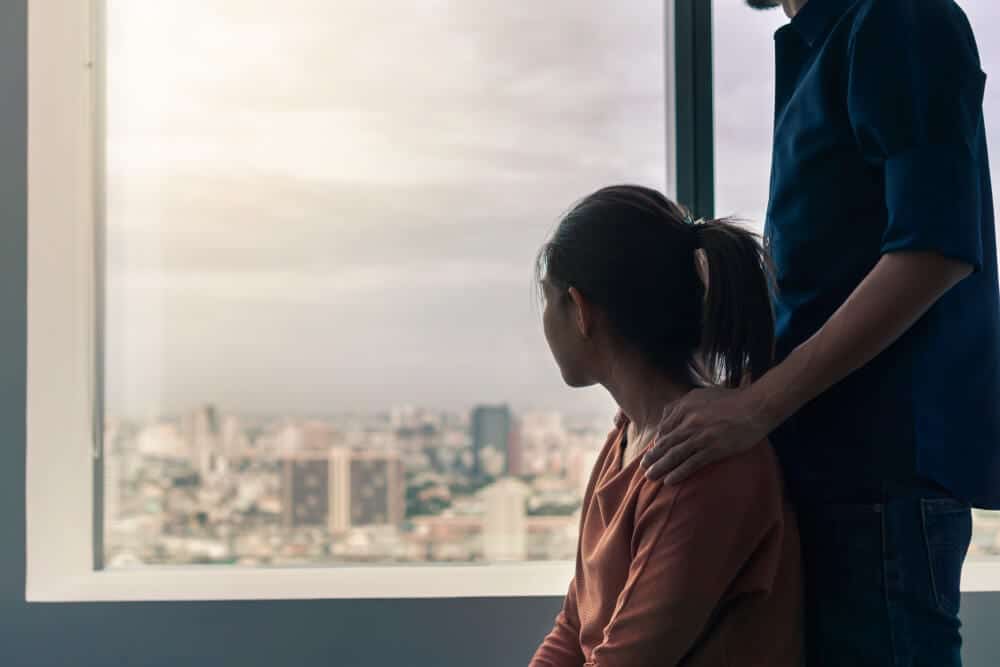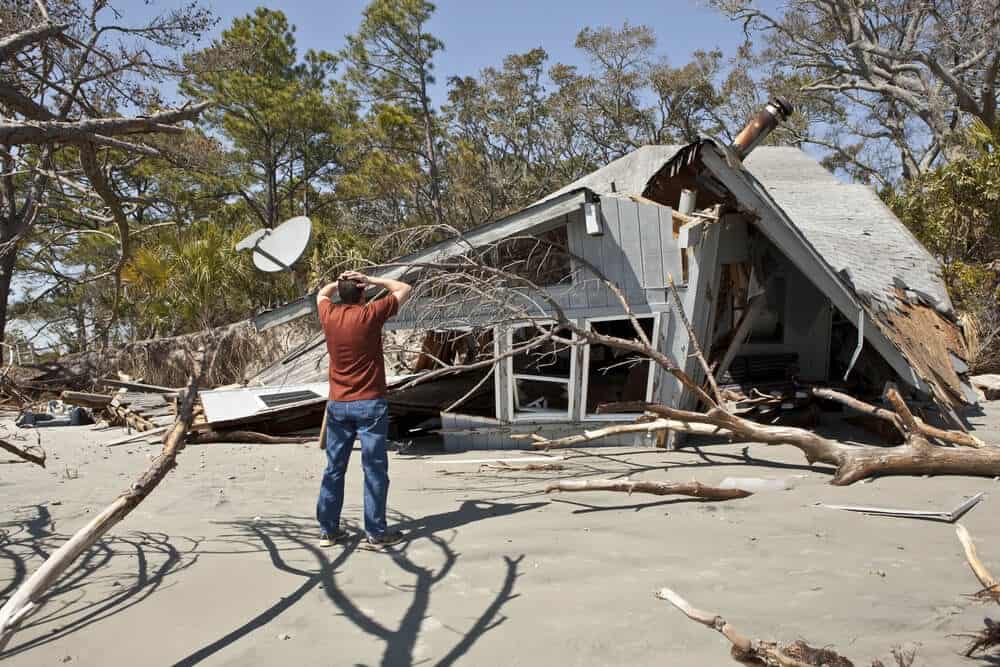
2019 has been the year of natural disasters. In July 2019, Hurricane Barry struck the Louisiana coast, causing $600 million worth of damages. More recently, wildfires struck Northern California, burning over 77,000 acres of forest in just ten days. Undoubtedly, these disasters affect the environment — but what about the people who live in it? Between 30 and 40 percent of direct victims of natural disasters suffer from symptoms of post-traumatic stress disorder or PTSD. This is shocking when compared with five to 19 percent of the general population.
Post-traumatic stress disorder, or PTSD, is a debilitating mental illness that strikes after a traumatic event — and natural disasters, being incredibly traumatic, are a common cause of PTSD for those who survive them.
All the natural disasters in the news lately highlight the importance of understanding PTSD and how it presents. So, here’s everything you need to know about PTSD and natural disaster victims to help yourself or someone you love to recover from such a devastating event.
What Is PTSD?
PTSD stands for post-traumatic stress disorder, which explains exactly what the condition is and how it develops: PTSD is a psychiatric disorder that develops when the mind and body don’t respond as expected to a traumatic event.
For a person with PTSD, a traumatic event — such as a natural disaster — isn’t just a one-time experience. They continue to relive the trauma of the event through flashbacks or nightmares, or suffer from negative cognitive or physical effects of the event.
Who Gets PTSD?
Statistics say that 70 percent of adults will experience at least one traumatic event in their lifetime — and of that number, 20 percent will go on to develop PTSD.
Anyone can develop PTSD following a traumatic experience, but some factors make a person more likely to develop it than others, including:
- Age. 5 percent of adolescents develop PTSD,
compared with 3.6 percent of adults. In other words, adolescents are slightly
more likely to develop this disorder than adults. - Gender. Numbers suggest that PTSD is much more
common in women than men — yet individuals of both genders can develop the
disorder. No one is immune to PTSD, but stigma about mental health and
masculinity may prevent men from seeking help. - Genetics. Like any psychiatric disorder, PTSD
has a strong genetic component. One study of 200,000 people revealed that the heritability
(or likelihood that a disorder or trait will run in families) of PTSD is
similar to that of depression or anxiety. - Co-occurring disorders. Having certain
psychiatric disorders can predispose a person to developing PTSD after a
traumatic event. These disorders include anxiety and substance abuse.
While having risk factors for PTSD doesn’t guarantee a person will develop it, it does make it more likely that a person’s response to a traumatic event will resemble PTSD.
Why PTSD Develops
PTSD develops in response to a traumatic event. However, trauma affects everyone differently. Experiencing trauma alone does not guarantee a person will develop PTSD, but it is required for a diagnosis of PTSD.
So, what exactly is a traumatic event? Trauma has less to do with the event itself, and more to do with the person’s individual experience. Because responses to events are so subjective, one person may experience an event as traumatic, while a second person does not view it as such.
A person does not need to experience the traumatic event firsthand to develop PTSD. Many people who experience a traumatic event second-hand through a close friend, family member or other loved one also experience symptoms of PTSD.
There’s no one definition of a traumatic event, nor is there a list of specific events that ‘count’ as traumatic. Any event can be traumatic if it is experienced in a way that triggers the body’s trauma response. However, going through certain events makes a person more likely to develop PTSD. These events include:
- Rape. 49 percent of rape victims will go on to develop PTSD — one of the highest correlations there is between a particular type of trauma and PTSD.
- Physical assault. 32 percent of people who experience severe physical assault exhibit symptoms of PTSD — and more than 15 percent of shooting and stabbing victims will, too.
- Serious accidents. 17 percent of victims of severe accidents will develop PTSD. Examples of these types of accidents include car, motorcycle, biking or train accidents.
- Unexpected deaths. Experiencing the sudden, unexpected death of a loved one leads to PTSD in 14 percent of victims. Additionally, more than 7 percent of people who witness the murder or serious injury of another person will develop PTSD.
- Natural disasters. Nearly 4 percent of people who experience a natural disaster go on to develop PTSD. These events can also lead to other traumas, such as injury or accident, or witnessing these events in other people.
Symptoms of PTSD
Many symptoms that may be considered ‘abnormal’ are actually normal, healthy responses to traumatic events. Physical and emotional responses to trauma are both common. These responses only become abnormal when they disrupt a person’s daily life or persist for an unusually long period of time following the trauma.
There are four main groups of symptoms implicated in PTSD. These groups are:
- Reliving the event through flashbacks or nightmares
- Avoiding leaving home, talking about the event or anything that reminds them of the traumatic experience
- Negative beliefs and discouraged attitude about life, friends and the world in general. This may include paranoia.
- Arousal symptoms, such as sleeplessness, difficulty concentrating or being startled easily
Professional help is recommended once these symptoms exceed one month and interfere with a person’s everyday activities. These symptoms can occur directly following the trauma, or later in a type of PTSD known as delayed-onset PTSD.
PTSD After Natural Disasters
Overall, approximately four percent of natural disaster victims develop PTSD — but “high-impact” natural disasters take an especially dire emotional toll on their victims. As many as 25 percent of people who are impacted, directly or indirectly, by these severe disasters will go on to develop PTSD.
Given the prevalence of high-impact natural disasters in places like Northern California and the Gulf Coast, it’s important to understand the symptoms of PTSD and where to seek help when they develop.
Why Natural Disasters Are Traumatic
According to SAMHSA-HRSA, traumatic events are experienced by an individual as physically or emotionally harmful or life-threatening, with lasting adverse effects on the individual’s functioning. A person can assess the number of traumatic experiences they’ve had (and how they might be affected) with the ACES
survey, which stands for the Adverse Childhood Experiences Study.
Natural disasters threaten a person’s health and well-being. They also disrupt a person’s everyday life by forcing them to evacuate. When a person evacuates due to a natural disaster, there is no guarantee that they will return to an intact house. The place where they grew up, and the people they care about, may not survive the disaster. This uncertainty can be extremely emotionally harmful to a person, making the event traumatic.
A natural disaster may also place a person in another circumstance that could be experienced as traumatic. For example, that person may witness the death of another person due to the natural disaster, the destruction of another person’s home due to the natural disaster or lose a loved one to the disaster.
People can also experience indirect trauma as the result of a natural disaster when someone they love lives through the disaster, even if they do not. This can lead to survivor’s guilt, and the feeling that they should have been there alongside the person suffering — or, if the person has passed away, that they should have passed away instead of the person they care about.
Where to Get Help After a Natural Disaster

Natural disasters are traumatic events that can lead to distressing symptoms or even PTSD. There’s no shame in seeking help after a natural disaster, especially if you think you are experiencing symptoms of PTSD. Here are some resources and information on types of treatment that can help you cope with a natural disaster.
Resources for Coping with Natural Disasters
The Center for Disease Control and Prevention provides information on its website about Coping with a Disaster or Traumatic Event, including how to cope with a natural disaster, recognize signs of stress caused by natural disasters, and helping adults and children relieve this stress caused by a disaster.
The American Red Cross responds to an emergency every eight minutes, including natural disasters. Their website can help you obtain financial assistance if you were a victim of a major 2017 or 2018 disaster.
SAMSA’s publication, Tips for Disasters, is designed to help individuals cope with grief after a natural disaster or another traumatic event. It provides information on PTSD, complicated grief and feelings of “survivor’s guilt.”
The National Center for PTSD has information on PTSD, conducts research on the disorder and gives strategies for self-help and treatment. They also have a clinical trials database that can help you find medical help for PTSD.
The Trauma Center at Justice Resource Institute has a collection of resources for children and families impacted by traumatic events. They also include links to outside resources, such as non-profit trauma organizations and foundations that provide help for PTSD sufferers.
The Life Events Checklist gives an idea of how many traumatic events you may have lived through as a child. Similarly, the PCL-C is a questionnaire designed for use in primary care that can help you assess if you are suffering from PTSD.
Types of Treatment for PTSD
If you suspect you are suffering from PTSD after a natural disaster, self-help strategies may not be enough. After consulting the above resources, you may want to consult your primary care doctor or a mental health professional for more targeted treatment designed to address your trauma response.
Therapy and medication are both valid types of treatment used to address PTSD. You may also consider seeking inpatient treatment for PTSD. Inpatient programs for PTSD allow you to disconnect from everyday life to focus on fully processing the natural disaster and learn to cope with symptoms of trauma. This way, when you return to your normal routine again, you will no longer feel controlled or disrupted by your PTSD.
Inpatient PTSD Treatment in Los Angeles focuses on improving your symptoms, teaching you coping strategies to deal with them and restoring your self-esteem following a traumatic event. Types of therapy for PTSD include cognitive processing, which focuses on fully reliving and processing what happened during the event, and prolonged exposure, which asks you to purposefully think about the traumatic event and practice easing your anxiety when you think about what happened.
